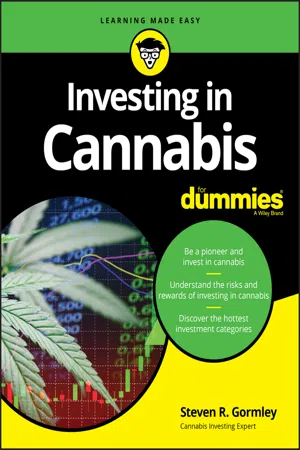
- English
- ePUB (mobile friendly)
- Available on iOS & Android
Investing in Cannabis For Dummies
About This Book
Invest in one of the most exciting and booming industries available today
Investing in Cannabis For Dummies takes readers on an illuminating and whirlwind tour of the legal cannabis investment industry. Written by a renowned expert in the world of cannabis, Steve Gormley (also known as the Cannabis Viking), this book provides an in-depth look at all aspects of publicly traded stocks (nationally and internationally) in the cannabis industry for medical or recreational use.
This book covers crucial topics for a firm understanding of investing in the cannabis industry, including:
- How to evaluate the strength of a cannabis company
- The differences between investing in public and private companies
- Investing in different cannabis silos - from cultivation, oils, and edibles, to technology
- Avoiding common scams and traps
- Trading strategy tips
Investing in Cannabis for Dummies is perfect for those who want to get in near the ground floor of an industry experiencing a massive expansion due to cannabis legalization around North America, Canada, and around the globe.
Frequently asked questions
Information
Getting Started with Cannabis Investing
Taking the Nickel Tour





Weighing the Pros and Cons of Investing in Cannabis
Pros
- Profit (which I already mentioned) is the biggie.
- Getting in at or near the bottom of a new and exciting industry is always a thrill. By investing in cannabis, you become a participant, not merely an observer, in the green rush.
- Being able to tell people you know that your investment portfolio or retirement account includes cannabis stock. This may sound silly, but being invested in cannabis says something about who you are and may help you engage in conversations you would otherwise be excluded from.
- If you consume marijuana, you get to invest in a product you enjoy and help to make it more available to others.
- If you invest in medical marijuana, you’re investing in medical research and helping to bring those new medicines to market, potentially alleviating some of the world’s physical and perhaps even mental suffering.
Cons
- Cannabis attracts money, and money attracts thieves. In addition, many novices eager to invest in cannabis are easy marks because they’re eager, naïve, and have money — just the combination of traits a con artist is looking for.Many of the successful entrepreneurs in cannabis got their start in the black market, which attracts a very particular personality type. Leopards don’t change their spots. Some savvy former black marketers have simply chosen a different crime — instead of dealing in illegal marijuana, they’re now on the prowl for unsuspecting investors they can fleece. And they’re not the only thieves that pose a threat to cannabis investors, as illustrated in the sidebar, “Crooks in law enforcement.”

- With lots of money flowing into the industry from eager investors, even legitimate cannabis stocks are overvalued. The more overvalued a stock is, the further the potential fall. Short sellers often target overvalued stocks just for this reason; then, when the stock price drops, they cash in and everyone else loses. (See Chapter 12 for more about short selling.)
- Cannabis businesses struggle to be profitable due to numerous factors, including the high costs of complying with federal, state, and local marijuana laws; increased security costs; increased bank fees; and the cost of specialized software.
- Cannabis stocks have an increased susceptibility to dilution because cannabis companies have a tougher time getting bank loans in the U.S. (due to federal laws that discourage banks from doing business with cannabis companies). Companies issue and sell more shares to raise money, but that dilutes the value of existing shares.
- Companies that grow cannabis are at risk of cannabis becoming a commodity, and if (when) that happens, prices and profits drop.
- Laws, and enforcement of those laws, are susceptible to change, and if they change in a direction that hurts cannabis businesses, their investors suffer as well.
- Supply-and-demand imbalances are common in the cannabis industry. These imbalances not only disrupt the supply chain but also negatively impact profits by creating market gluts (which drive down prices) or shortages (which increase costs and reduce demand); either way, profits suffer.
- Cannabis still has a healthy black market, even in states where it’s legal, and black-market growers and dealers don’t pay taxes, so they can afford to sell their product for less. If state and local authorities don’t crack down on illegal production and sales, legal businesses have a tough time competing.
Deciding Whether to Invest in Businesses That Touch the Plant or Those That Don’t
- Plant-touching: These businesses come into contact with the plant at some point during the growth, manufacturing, distribution, or sale. They include grow operations, manufacturers of infused products (MIPs), shipping firms, dispensaries, and licensed delivery services. Plant-touching businesses stand to profit most from cannabis, and they’re also at the greatest risk of suffering losses when the industry takes a hit.If you decide to invest in a plant-touching business, consider a vertically integrated company, which means the business does its own cultivation, manufac...

Table of contents
- Cover
- Title Page
- Table of Contents
- Introduction
- Part 1: Getting Started with Cannabis Investing
- Part 2: Doing Your Homework
- Part 3: Buying and Selling Cannabis Stocks, ETFs, or Mutual Funds
- Part 4: Exploring Cannabis Investment Strategies
- Part 5: The Part of Tens
- Index
- About the Author
- Advertisement Page
- Connect with Dummies
- End User License Agreement